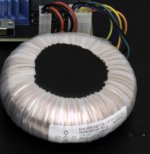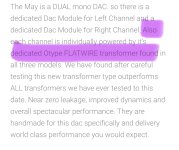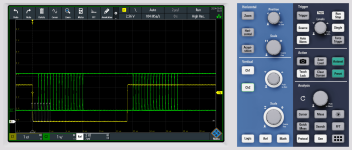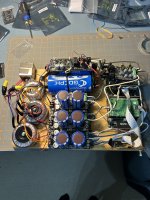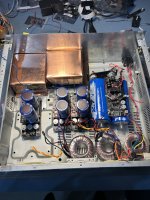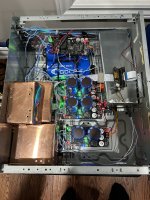Looks like they produce custom on demand only. Drop them a message in the contact form, see what they say. I'll definitely do that next time I need a transformer.
Yeah, guess I will have to do that.
On the product page for toroidal transformers it mentions a file to download, which doesn't exist 🙂
Also, I see they produce O core transformers. But zero information besides that they can produce them on order.
I wonder if O core transformers ban be produced with multiple secondary windings.
Like 3*9V.
On the product page for toroidal transformers it mentions a file to download, which doesn't exist 🙂
Also, I see they produce O core transformers. But zero information besides that they can produce them on order.
I wonder if O core transformers ban be produced with multiple secondary windings.
Like 3*9V.
Yes, I am afraid if you are interested you must contact them through their website, because they custom-build their transformers and thus are not available on their e-shop. However, Giatras is a well respected company for transformers in Greece and many audio manufacturers use them.I noticed that as well. But where to buy Giatras?
Their site isn't exactly informative of that.
It's a family business. I've picked my transformers from them directly (downtown Athens).
@pkonstantinidis Bit far on my bicycle from the Netherlands ;-)
Which specifications did you go with, and what did it cost?
Which specifications did you go with, and what did it cost?
@pkonstantinidis I was thinking that too, but wouldn't mind a bit higher Amp on the secondaries.
I wonder, and will ask, if they can shield a O transformer as well.
But what did it cost you?
I wonder, and will ask, if they can shield a O transformer as well.
But what did it cost you?
@weust I guess they can do whatever you ask them to. Mine was with IP56 shielding. I've just checked and the cost was 55€ + 24% VAT (in Greece it's 24%). So, the final cost was 68.2€.
Not bad in my opinion for a shielded transformer with three secondaries. YMMV.
Not bad in my opinion for a shielded transformer with three secondaries. YMMV.
Not bad, indeed.
21% here, plus I will have to add shipping costs, but that is to be expected of course.
21% here, plus I will have to add shipping costs, but that is to be expected of course.
Considering the UC Pure MkII vs. MkIII
looks like the only difference is sync charging.
I would not be using sync charging so maybe could get by with UC Pure MkII
looks like the only difference is sync charging.
I would not be using sync charging so maybe could get by with UC Pure MkII
Speaking of “O” transformers, anyone know what HOLO is using in their KTE version?Also, I see they produce O core transformers. But zero information besides that they can produce them on order.
I wonder if O core transformers ban be produced with multiple secondary windings.
Like 3*9V.
Attachments
I guess they used to sell them or some sort of version of it. Looks completely done in house. Interesting unobtainium for us mere mortals 
https://www.kitsunehifi.com/product/flying-ninja-poster/

https://www.kitsunehifi.com/product/flying-ninja-poster/
You have O-type transformers here, so you can always email and ask what you need.
https://iwistao.com/products/iwista...5v-for-dac-preamp-headphone-amp-free-shipping
https://iwistao.com/products/iwista...5v-for-dac-preamp-headphone-amp-free-shipping
Shipping and import taxes will be high though.
In my case I would rather stick to a company within the EU.
In my case I would rather stick to a company within the EU.
@iancanada or anyone else …..
quick question… as I am scratching my head and look for a confirmation if the following is correct or not
i run ropieee on an RPI followed by a FiFoPi Q2. The DAC HAT in Ropieee is Generic I2S
Now, when I measure LR and Data signals, I am getting padded ones in stead of the expected padded zeroes at the end of the word.
for A DAC accepting I2S, this is no issue as it all LSB stuff
but….. testing a R2R DAC from Stefano, I get weird results like cut in half sinus signals as these “padded ones“ are crossing with the very last bit the LR transition and this is seen by that DAC as MSB… (I2S MSB is coming one clock cycle after the LR transitioning)….
i suspect the DAC to work with Left Justified signal ins stead of true I2S
if there would be true zero padding, therebwould Be less of a problem, only 6dB less signal
Ian, may be you or anyone else might have an idea On the ones padding. Might even be an issue of the ropieee of course
quick question… as I am scratching my head and look for a confirmation if the following is correct or not
i run ropieee on an RPI followed by a FiFoPi Q2. The DAC HAT in Ropieee is Generic I2S
Now, when I measure LR and Data signals, I am getting padded ones in stead of the expected padded zeroes at the end of the word.
for A DAC accepting I2S, this is no issue as it all LSB stuff
but….. testing a R2R DAC from Stefano, I get weird results like cut in half sinus signals as these “padded ones“ are crossing with the very last bit the LR transition and this is seen by that DAC as MSB… (I2S MSB is coming one clock cycle after the LR transitioning)….
i suspect the DAC to work with Left Justified signal ins stead of true I2S
if there would be true zero padding, therebwould Be less of a problem, only 6dB less signal
Ian, may be you or anyone else might have an idea On the ones padding. Might even be an issue of the ropieee of course
Update: It must be Ropieee.... also at the RPI data output i get "ones" for "zero" bit positions. It seems as if in Ropieee the Data output is inverted.... I can check with a simple inverter if the data comes out right and things still work. Next week or so or after. I will inform Ropieee as well. this should not be the case
Yes, this is how it looks
compltely changing my streamer setup, Rock, Roon, RPI with Ropieee is for now a bridge to far, just to do some tests of course.
any way, Stefano is very supportive and we are looking to see what could cause the main issue of the Stefano DAC not working as expected. It works on my AP whee I can meddle around with timing and I2S signals…
compltely changing my streamer setup, Rock, Roon, RPI with Ropieee is for now a bridge to far, just to do some tests of course.
any way, Stefano is very supportive and we are looking to see what could cause the main issue of the Stefano DAC not working as expected. It works on my AP whee I can meddle around with timing and I2S signals…
Attachments
A few weeks ago I posted a question about Ian stack and how sensitive to RFi/EMI it was. Well at the time I was testing on an open board. Since then I moved everything in an enclosure. I shielded the three toroidal transformers with stainless steel. The stack is on a StationPi and shielded as follow. A separate copper shield box for the receiver PI and RPI. The FifoPIQ7 and the dual mono DAC are seperated by a copper board and both units are then enclosed in a copper shield box. Finally the OPA861 sits on top and is also separately shielded with its own copper box. Did it make a difference? Yes but… don’t expect a huge difference. What I hear is exactly the same sound character but with more clarity and easier capacity to discern small details. Overall I am happy with the result. Attached are before and after pics.
Attachments
@Martin923
To use stainless steel to cover the transformers might not get the best result due to the limited or non-magnetic properties of stainless steel.
Please realise in EMI we have 2 situations:
Magnetic fields, mainly from transformers and current going trough wires, PCB traces and are mostly low frequency up to a few hundred kHz ?
Twisted wires compensates most of the magnetic fields as each wire has the magnetic field in opposite direction to the other so they counteract each other.
The magnetic field is dependant on current strength so a few mA on a PCB will hardly be an issue.
A transformer is a magnetic source that could use magnetic shielding but then the shield must have magnetic properties like iron or steel. Some kinds of stainless steel have very limited or almost none magnetic properties so hardly protect against magnetic.
Then there are radiated signals (think of wifi, mobile phones, AM/FM radio) which goes into the MHz range.
For these you can use any kind of metallic shields like aluminium, copper foil and also stainless steel and more.
To use stainless steel to cover the transformers might not get the best result due to the limited or non-magnetic properties of stainless steel.
Please realise in EMI we have 2 situations:
Magnetic fields, mainly from transformers and current going trough wires, PCB traces and are mostly low frequency up to a few hundred kHz ?
Twisted wires compensates most of the magnetic fields as each wire has the magnetic field in opposite direction to the other so they counteract each other.
The magnetic field is dependant on current strength so a few mA on a PCB will hardly be an issue.
A transformer is a magnetic source that could use magnetic shielding but then the shield must have magnetic properties like iron or steel. Some kinds of stainless steel have very limited or almost none magnetic properties so hardly protect against magnetic.
Then there are radiated signals (think of wifi, mobile phones, AM/FM radio) which goes into the MHz range.
For these you can use any kind of metallic shields like aluminium, copper foil and also stainless steel and more.
- Home
- Source & Line
- Digital Line Level
- Asynchronous I2S FIFO project, an ultimate weapon to fight the jitter
